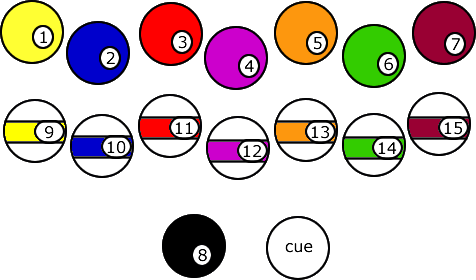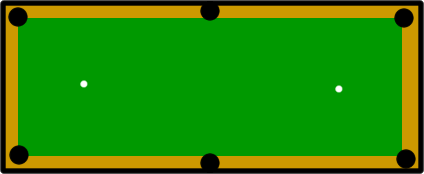The activity of shooting pool evolved from a form of French croquet. Played on a lawn, a ball (or bille, hence the title billiards) would be shoved around the field by wooden maces. The game was then moved inside - French royalty hated to sweat - but to keep the connection to the lawn, the game was played on a table covered with green cloth to represent grass. How regal.
All that history is fine and dandy, but we prefer the current image of pool: a dimly lit barroom filled with wispy strands of smoke, while you, with a pool cue in one hand and a brew in the other, stand there and look dangerous. It's a well-documented fact that if you hold a cue stick in your hand, your coolness level increases exponentially. We're here to make sure that you can do more than merely look cool while waiting for your turn. So read on and learn the basics about shooting pool.
And, if you need all the cool points you can get, don't mull over the steps. Get on the ball and view this video.
WATCH THIS HOW-TO VIDEO
1. FAMILIARIZE YOURSELF WITH THE EQUIPMENT
Um, isn't there like some balls and a table and other stuff? A brilliant analysis! To be more specific, here are the main pieces of equipment with which you should familiarize yourself:
Balls
Cue stick
Table
Rack
Balls

Ooh, look at all the pretty colors! The first thing to know about pool is that there are many balls. Some of these balls are solids, meaning that the entire ball is one color, and some of these balls are stripes, meaning that the balls have white tops and bottoms, with a colored stripe painted around the middle.
Each ball also has a number on it, 1 - 15. All of the balls 1 - 7 are solids, and all the balls 9 - 15 are stripes. What about the 8-ball? Well, when playing standard pool, the 8-ball is not considered a solid nor a stripe; it's special. Don't worry, you won't miss the 8-ball -- it's all black.
There is one more ball that you'll use when playing pool, but it doesn't have a number on it. It's the cue ball, and it's the ball that you'll hit with the cue stick. When playing pool, you never hit any of the balls directly with the stick; you only hit the cue ball with the stick, and then the cue ball bounces into other balls and knocks them into the holes on the table.
Cue stick
The cue stick is the stick you use to hit the cue ball. It's long and pointy, so be careful; many an eye has been poked out by a rambunctious player who decided to play conductor and use the cue stick as a baton. A cue stick has three parts:
- The tip: the little white piece -about half an inch long-at the end of the skinnier half of the stick.
- The shaft: the smooth, narrow length between the tip and the middle of the stick.
- The butt: the thicker portion of the stick that falls between the middle and the end, with a rubber bumper on the very bottom
Stop snickering. We didn't invent the names. Pool sticks are free for the borrowing at pool halls. Don't try filching one because the owners will spot it sticking out of your back pocket. Don't worry about the length of a cue stick (most of them are about 58 inches long), but if you feel that your cue is too heavy, switch to a lighter one; what you lose in power, you'll gain in control.
Table
We realize that the "artistic" rendering below is woefully out of scale. But until our art budget increases, perhaps you'll be satisfied with this image of a standard pool table:

A pool table is about 4 feet wide, 9 feet long, and usually has a velvet-ish surface (acutally, it's polyester and wool). On the table, there are 6 pockets: there are 4 corner pockets (shockingly located at the four corners of the table) and 2 side pockets, one in the center of each long side of the table.
A pool table also has rails. These are the borders around the edges of a pool table where people rest their beers. There are two important things to know about the rails: 1) you'll be using them to balance your non-dominant hand to make rail bridges; and 2), you should NEVER put any drink or food item on the rail. If it spills onto the table, the surface material will need to be replaced, and then you'll cry because it costs a lot of money to do this (at least $150).
One last thing about the table: near each end, there's a little white circle called a spot. You need those, because when you set up the balls at the beginning of a pool game, the front ball will rest on the foot spot, while you'll set the cue ball on the head spot.
Rack
The rack is the triangular thing that players use to arrange the balls into a neat triangle shape before the game starts. See it in the picture on the top of the page? The process of using a rack is called racking, and there is an art to it:
- Pack all the balls into the rack.
- With your fingers inside the back end of the rack, push the balls forward and close together within it. All adjacent balls should be touching.
- Rack with the front ball centered on the foot spot.
- When you lift the rack, the balls should remain snugly packed together.
The last two common pieces of pool equipment are the mechanical bridge and the chalk. Don't worry too much about these; we'll discuss them later. Just know that you use the bridge to help you make tough-to-reach shots, and you use the chalk to help your cue stick connect with the ball.

